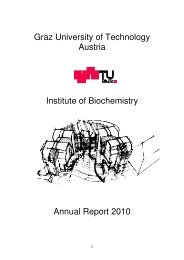Staff Members of the Institute of Biochemistry, TU - Institut für ...
Staff Members of the Institute of Biochemistry, TU - Institut für ...
Staff Members of the Institute of Biochemistry, TU - Institut für ...
Create successful ePaper yourself
Turn your PDF publications into a flip-book with our unique Google optimized e-Paper software.
Pichia pastoris organelles<br />
The yeast Pichia pastoris is an important experimental system for heterologous expression <strong>of</strong><br />
proteins. Never<strong>the</strong>less, surprisingly little is known about organelles <strong>of</strong> this microorganism.<br />
For this reason, we started a systematic biochemical and cell biological study to establish<br />
standardized methods <strong>of</strong> Pichia pastoris organelle isolation and characterization. Recent work<br />
focused on <strong>the</strong> biochemical characterization <strong>of</strong> mitochondrial membranes and <strong>the</strong> plasma<br />
membrane from Pichia pastoris grown on different carbon sources. The major aim <strong>of</strong> this<br />
project was <strong>the</strong> qualitative and quantitative analysis <strong>of</strong> phospholipids, fatty acids and sterols<br />
from both types <strong>of</strong> membranes, when Pichia pastoris was grown on different carbon sources.<br />
We also started to study selected lipid syn<strong>the</strong>sizing enzymes from Pichia pastoris with<br />
emphasis on <strong>the</strong> PE biosyn<strong>the</strong>tic machinery. We identified two Pichia pastoris PS<br />
decarboxylases (PSD) encoded by genes homologous to PSD1 and PSD2 from<br />
Saccharomyces cerevisiae (Figure 3). Using Pichia pastoris psd1 and psd2 mutants we<br />
investigated <strong>the</strong> role <strong>of</strong> <strong>the</strong>se two gene products in PE syn<strong>the</strong>sis and <strong>the</strong> effect <strong>of</strong> <strong>the</strong>ir<br />
deletions on cell growth. Mitochondrial Psd1p is <strong>the</strong> major enzyme for PE syn<strong>the</strong>sis in Pichia<br />
pastoris. Deletion <strong>of</strong> PSD1 caused a loss <strong>of</strong> PSD activity in mitochondria and a severe growth<br />
defect on minimal media which was partially cured by supplementation with ethanolamine.<br />
This result indicated that <strong>the</strong> CDP-ethanolamine but not <strong>the</strong> Psd2p pathway provided<br />
sufficient PE for cell viability in a psd1 background. Under <strong>the</strong>se conditions, however,<br />
cellular and mitochondrial PE levels were dramatically reduced. Fatty acid analysis from wild<br />
type, psd1 and psd2 demonstrated <strong>the</strong> selectivity <strong>of</strong> both PSDs in vivo for <strong>the</strong> syn<strong>the</strong>sis <strong>of</strong><br />
unsaturated PE species. Short chain saturated (16:0) PE species were preferentially imported<br />
into mitochondria irrespective <strong>of</strong> psd1 or psd2 deletions. Thus, biosyn<strong>the</strong>sis and subcellular<br />
distribution contribute to PE homeostasis in mitochondria <strong>of</strong> Pichia pastoris.<br />
.<br />
Figure 3:<br />
Phylogenetic tree <strong>of</strong> PSD sequences from different organisms. The tree was constructed using<br />
<strong>the</strong> neighbor joining (NJ) method <strong>of</strong> <strong>the</strong> CLUSTALW program.<br />
20














